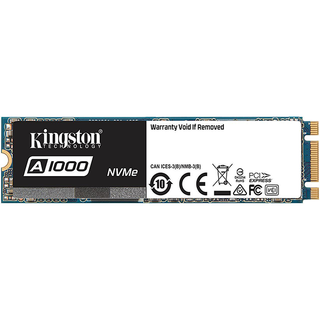Kingston A1000 NVMe SSD Review: Low Cost NVMe
Why you can trust Tom's Hardware
Conclusion
The NVMe protocol is designed to supercharge storage and take us beyond the limits of the old SATA bus. There are many products available that do just that, but the Kingston A1000 isn't one of them.

It's disappointing to have the new lean NVMe command set that was designed to reduce latency used for a product that has higher latency than a SATA SSD. If you want SATA performance, you can still get it with lower cost SATA products, and in some cases get a more responsive system (Crucial MX500, Samsung 850/860 EVO, and so on).
The A1000's increased sequential read and write throughput separates it from the SATA products. That helps when you transfer large files, like movies, music, and high-resolution pictures. We all perform these tasks on a routine basis and a 3X reduction in the time it takes to complete the transfers is significant, but we don't think those tasks warrant taking a hit in system responsiveness to save you a few minutes per day.
There are other low-cost NVMe SSDs that offer better throughput and system responsiveness, but you have to pay a little more for them. The Adata XPG SX8200 and HP EX920 are two of our favorite examples, but Samsung's reduced 970 EVO pricing has moved the series into the same category.
There are some places where the Kingston A1000 makes sense. The drive is a good fit if you just want a PCI Express SSD to reduce or eliminate cable clutter while spending the least amount possible. Small form factor system builds, for example, go much better without a SATA and power cable spanning the distance of the case to power a storage product. Another example is adding an inexpensive secondary SSD to your system for cold storage.
The SX8200 and EX920 mainstream SSDs are pushing down prices, so we would like to see the A1000 price drop sharply. Flash is the most expensive component in an SSD–the controller and DRAM only add up to a small portion of the overall cost. Companies want to make money on these products, but it's hard to shave any meaningful amount off the overall price of the SSD by saving a little on a slower controller.
From a buyer’s perspective, we have to look at it from the opposite direction. Do you really want to save just a few dollars for a "less than" experience when you have to live with the results of that decision for years to come? Spending just a little more today can extend your future upgrade cycle by giving you the satisfaction and sense of better performance right away rather than looking for more in the future.
Capacities Rated
MORE: Best SSDs
MORE: How We Test HDDs And SSDs
MORE: All SSD Content
Stay on the Cutting Edge
Join the experts who read Tom's Hardware for the inside track on enthusiast PC tech news — and have for over 25 years. We'll send breaking news and in-depth reviews of CPUs, GPUs, AI, maker hardware and more straight to your inbox.
-
nobspls Need Temperature data for NVME drives. Not all of them are qualified for notebook use because of the heat problems.Reply -
almarcy Just want to brag on my new Samsung 860 EVO SATA 6Gb/S. My old PC is an ATX behemoth dinosaur, but, it now stings like a bee! Slow is relative, but FAST is always FUN, while it lasts. Fun just fades, sometimes...Reply


